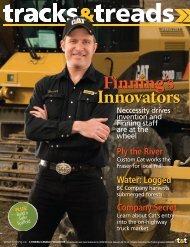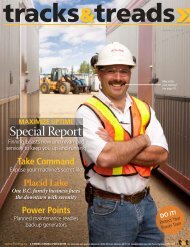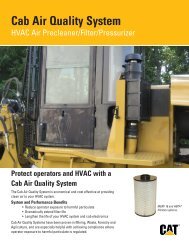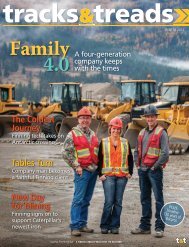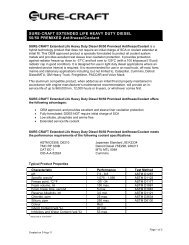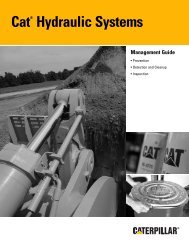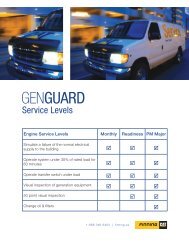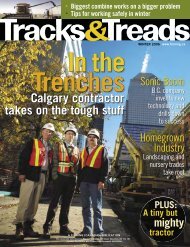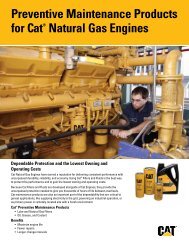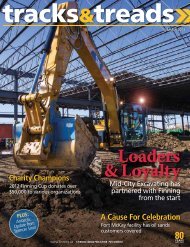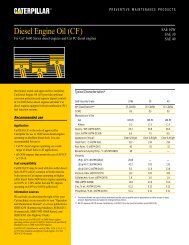Caterpillar - Finning Canada
Caterpillar - Finning Canada
Caterpillar - Finning Canada
Create successful ePaper yourself
Turn your PDF publications into a flip-book with our unique Google optimized e-Paper software.
Safety FirstBRINGING A PILLOW AND BLANKET TO WORK FOR A NAP DURING A SHIFTIS NOT SEEN AS BEING A CAREER-ENHANCING MOVE WRITES KERRYTREMBLAY. BUT IN THE NOT TOO DISTANT FUTURE, IT MIGHT BETaking a BreakFatigue is a big issue. Workers are human,and humans get tired. Statistics fromthe United States suggest more than $46billion per year in costs are lost to sleeprelatedaccidents. Furthermore, more than40 million Americans suffer from undiagnosedsleeping disorders. No similar studiesexist for <strong>Canada</strong>, but similar issuesexist in this country.On the job fatigue impairment is beingcompared to drinking and driving. Writingfor OHS <strong>Canada</strong> in March,2001, Carolyn Schur, presidentof Alert@Work Human ResourceServices, a Canadian consultant onfatigue management says: “When Ithink about where we are with ourefforts to deal with fatigue, sleepinessand long or rotating workschedules, I think about where wewere with the drinking and drivingissue 30 years ago, when nearly halfof all fatalities on the road involveddrinking and driving. We knew itwas a problem...but we didn’t takeit as seriously as we do today.”That’s backed by a February,2005 Fatigue Management Guidereleased by Workplace Healthand Safety for Australia’s state ofQueensland. “Recent studies haveshown that staying awake for 17 hoursleads to the same level of impaired performanceas having a blood-alcohol contentof 0.05%. Staying awake for 21 hoursis equivalent to a blood alcohol content of0.1%.” The legal limit for blood alcohollevels in Canadian drivers is 0.08%.“Fatigue is mental or physical exhaustionthat stops a person from being able tofunction normally, and is mainly causedby a lack of sleep,” the management guideoutlines. Fatigue can be caused by all kindsof issues: workload, length of shift, previousnumber of days worked, shift schedulesand time of day. A host of other factorscome into play, such as having a new babyat home, a second job, eating fatty foods orbeing on-call.There’s increasing talk from researchers,governments and safety associationssuggesting fatigue is a huge, often unmeasuredfactor in accidents. The difficulty isthere are very few ways to measure it.Some companies, as part of due diligenceand emergency preparedness,are setting up backup plans to cover forfatigued workers. A newly- released studyby British Columbia’s Forestry Task forcesays on-going health and wellness andsupport programs must effectively addresscurrent and emerging physical and mentalconditioning issues, including fatigue.There are two kinds of fatigue, saysSchur. “These are physical fatigue (likewhen one has just finished a physicallyheavy job or run a race), and cognitiveor mental fatigue. That’s when the brainzones out (maybe only for a few seconds)and doesn’t even recognize that it has.It’s one thing if that happens in a meetingand another if it happens on a bigmachine or operating heavy equipment.Then it becomes a dangerous situation.Someone who is cognitively fatigued hasthe same lack of judgement as ones whoare impaired through drinking alcohol.Impaired is impaired is impaired.” That,she says, “is the bottom line.”One of the bigger factors – and onethat humans have little control over – iscalled circadian rhythm. It’s the internalbody clock that affects everything frombody temperature to digestion, hormonelevels and blood pressure. Since humansare generally diurnal (day-oriented), thebody temperature drops slightlyafter lunch and then dips more inthe early morning hours. That earlyafternoon dip is why people getsleepy in the afternoon. Naps maybe a solution, but at work has a stigmaattached to it. People stereotypeprofessionals who nap as weak, lazyor unproductive. However, naps canmaintain alertness and performance,researchers suggest.Transportation companies arealready taking a hard look at howtired drivers get. So are companieslike Canadian National RailwayCompany and a handful of others.Some companies in the U.S. are supplyingrooms that workers can napin for 20 to 40 minutes, whetherthey are working the day, evening ornight shift. And one company in New YorkCity has created a business of providingnap space for sleepy office workers – at $14US per nap.The numbers are fuzzy on the effect offatigue on work place safety and efficiency.But the vast majority of the information onthe subject suggests following the safetyaxiom – recognize the problem, understandthe solution and act in time. Maybeit’s time to wake up and let workers nap.ILLUSTRATION BY SYLVIE BOURBONNIÈRE20 TRACKS & TREADS • Summer 2005 www.finning.ca




